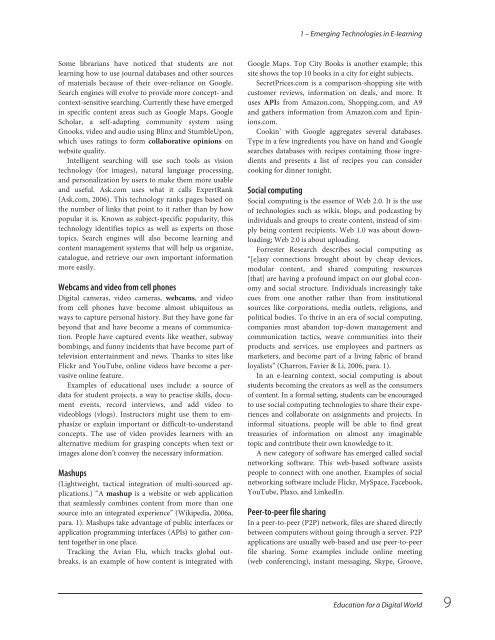Education for a Digital World Advice, Guidelines and Effective Practice from Around Globe, 2008a
Education for a Digital World Advice, Guidelines and Effective Practice from Around Globe, 2008a
Education for a Digital World Advice, Guidelines and Effective Practice from Around Globe, 2008a
You also want an ePaper? Increase the reach of your titles
YUMPU automatically turns print PDFs into web optimized ePapers that Google loves.
1 – Emerging Technologies in E-learning<br />
Some librarians have noticed that students are not<br />
learning how to use journal databases <strong>and</strong> other sources<br />
of materials because of their over-reliance on Google.<br />
Search engines will evolve to provide more concept- <strong>and</strong><br />
context-sensitive searching. Currently these have emerged<br />
in specific content areas such as Google Maps, Google<br />
Scholar, a self-adapting community system using<br />
Gnooks, video <strong>and</strong> audio using Blinx <strong>and</strong> StumbleUpon,<br />
which uses ratings to <strong>for</strong>m collaborative opinions on<br />
website quality.<br />
Intelligent searching will use such tools as vision<br />
technology (<strong>for</strong> images), natural language processing,<br />
<strong>and</strong> personalization by users to make them more usable<br />
<strong>and</strong> useful. Ask.com uses what it calls ExpertRank<br />
(Ask.com, 2006). This technology ranks pages based on<br />
the number of links that point to it rather than by how<br />
popular it is. Known as subject-specific popularity, this<br />
technology identifies topics as well as experts on those<br />
topics. Search engines will also become learning <strong>and</strong><br />
content management systems that will help us organize,<br />
catalogue, <strong>and</strong> retrieve our own important in<strong>for</strong>mation<br />
more easily.<br />
Webcams <strong>and</strong> video <strong>from</strong> cell phones<br />
<strong>Digital</strong> cameras, video cameras, webcams, <strong>and</strong> video<br />
<strong>from</strong> cell phones have become almost ubiquitous as<br />
ways to capture personal history. But they have gone far<br />
beyond that <strong>and</strong> have become a means of communication.<br />
People have captured events like weather, subway<br />
bombings, <strong>and</strong> funny incidents that have become part of<br />
television entertainment <strong>and</strong> news. Thanks to sites like<br />
Flickr <strong>and</strong> YouTube, online videos have become a pervasive<br />
online feature.<br />
Examples of educational uses include: a source of<br />
data <strong>for</strong> student projects, a way to practise skills, document<br />
events, record interviews, <strong>and</strong> add video to<br />
videoblogs (vlogs). Instructors might use them to emphasize<br />
or explain important or difficult-to-underst<strong>and</strong><br />
concepts. The use of video provides learners with an<br />
alternative medium <strong>for</strong> grasping concepts when text or<br />
images alone don’t convey the necessary in<strong>for</strong>mation.<br />
Mashups<br />
(Lightweight, tactical integration of multi-sourced applications.)<br />
“A mashup is a website or web application<br />
that seamlessly combines content <strong>from</strong> more than one<br />
source into an integrated experience” (Wikipedia, 2006a,<br />
para. 1). Mashups take advantage of public interfaces or<br />
application programming interfaces (APIs) to gather content<br />
together in one place.<br />
Tracking the Avian Flu, which tracks global outbreaks,<br />
is an example of how content is integrated with<br />
Google Maps. Top City Books is another example; this<br />
site shows the top 10 books in a city <strong>for</strong> eight subjects.<br />
SecretPrices.com is a comparison-shopping site with<br />
customer reviews, in<strong>for</strong>mation on deals, <strong>and</strong> more. It<br />
uses APIs <strong>from</strong> Amazon.com, Shopping.com, <strong>and</strong> A9<br />
<strong>and</strong> gathers in<strong>for</strong>mation <strong>from</strong> Amazon.com <strong>and</strong> Epinions.com.<br />
Cookin’ with Google aggregates several databases.<br />
Type in a few ingredients you have on h<strong>and</strong> <strong>and</strong> Google<br />
searches databases with recipes containing those ingredients<br />
<strong>and</strong> presents a list of recipes you can consider<br />
cooking <strong>for</strong> dinner tonight.<br />
Social computing<br />
Social computing is the essence of Web 2.0. It is the use<br />
of technologies such as wikis, blogs, <strong>and</strong> podcasting by<br />
individuals <strong>and</strong> groups to create content, instead of simply<br />
being content recipients. Web 1.0 was about downloading;<br />
Web 2.0 is about uploading.<br />
Forrester Research describes social computing as<br />
“[e]asy connections brought about by cheap devices,<br />
modular content, <strong>and</strong> shared computing resources<br />
[that] are having a profound impact on our global economy<br />
<strong>and</strong> social structure. Individuals increasingly take<br />
cues <strong>from</strong> one another rather than <strong>from</strong> institutional<br />
sources like corporations, media outlets, religions, <strong>and</strong><br />
political bodies. To thrive in an era of social computing,<br />
companies must ab<strong>and</strong>on top-down management <strong>and</strong><br />
communication tactics, weave communities into their<br />
products <strong>and</strong> services, use employees <strong>and</strong> partners as<br />
marketers, <strong>and</strong> become part of a living fabric of br<strong>and</strong><br />
loyalists” (Charron, Favier & Li, 2006, para. 1).<br />
In an e-learning context, social computing is about<br />
students becoming the creators as well as the consumers<br />
of content. In a <strong>for</strong>mal setting, students can be encouraged<br />
to use social computing technologies to share their experiences<br />
<strong>and</strong> collaborate on assignments <strong>and</strong> projects. In<br />
in<strong>for</strong>mal situations, people will be able to find great<br />
treasuries of in<strong>for</strong>mation on almost any imaginable<br />
topic <strong>and</strong> contribute their own knowledge to it.<br />
A new category of software has emerged called social<br />
networking software. This web-based software assists<br />
people to connect with one another. Examples of social<br />
networking software include Flickr, MySpace, Facebook,<br />
YouTube, Plaxo, <strong>and</strong> LinkedIn.<br />
Peer-to-peer file sharing<br />
In a peer-to-peer (P2P) network, files are shared directly<br />
between computers without going through a server. P2P<br />
applications are usually web-based <strong>and</strong> use peer-to-peer<br />
file sharing. Some examples include online meeting<br />
(web conferencing), instant messaging, Skype, Groove,<br />
<strong>Education</strong> <strong>for</strong> a <strong>Digital</strong> <strong>World</strong> 9


















